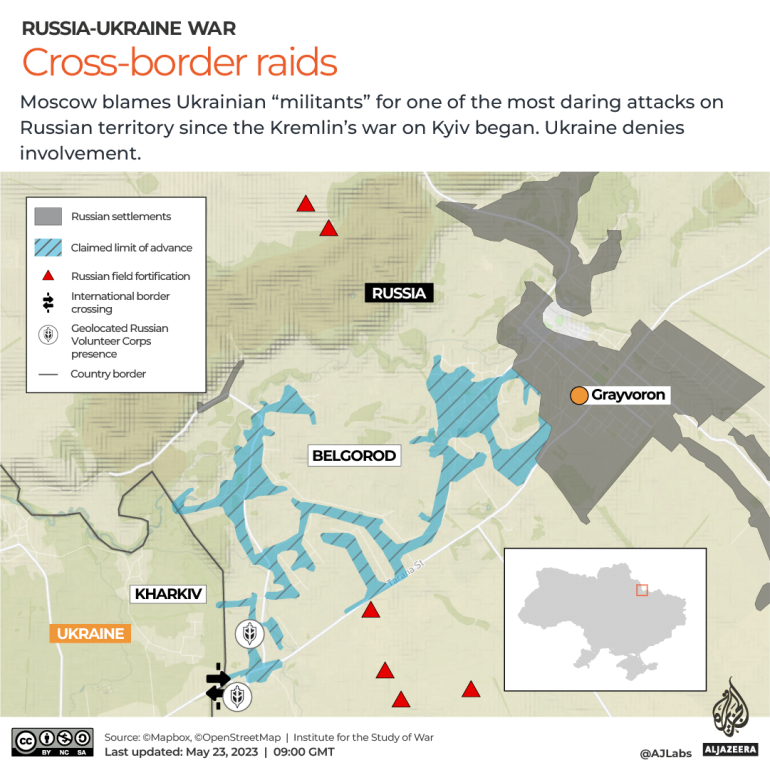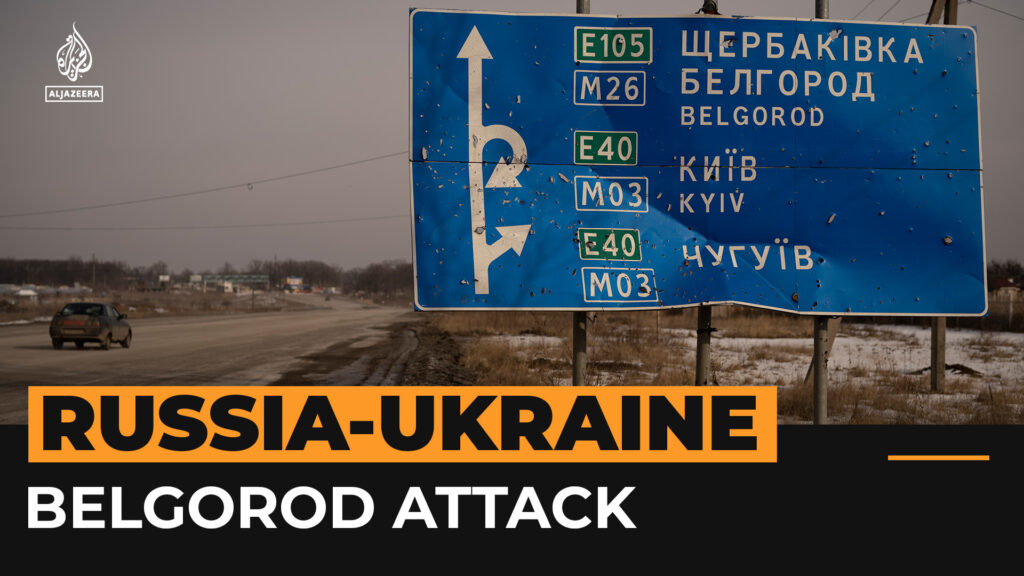Fifteen months after Moscow’s troops invaded Ukraine, one of the largest and most daring cross-border attacks since the war began was carried out by Russia.
On Monday, two anti-Kremlin groups – the Russian Volunteer Corps (RVC) and Freedom of Russia Legion – claimed responsibility for the attack in the Belgorod region.
Fighting continued for a second day early on Tuesday. A dozen people were reported injured and several residents were evacuated.

Later on Tuesday, Russia’s Ministry of Defense said the units it blamed had been forced back into Ukrainian territory. More than 70 attackers were killed, the ministry said, a number that was not possible to verify.
After accusing Ukraine, Russia opened a “terrorism” investigation. Kyiv officials say they have nothing to do with the attacks.
Here’s what we know so far:
Where is Belgorod?
Russia’s Belgorod province borders Ukraine’s Luhansk, Sumy and Kharkiv regions.
It is about 600km (373 miles) from the Russian capital, Moscow, and has become a front-line region, serving as an important base for the Kremlin’s armed forces to launch attacks into Ukraine.
But Belgorod also exposed Russia’s weaknesses.
Moscow accidentally bombed the city of Belgorod last month, while fFuel and ammunition stores in the region have been rocked by explosions since the start of the war.
What happened in Belgorod?
Earlier on Monday, Belgorod Governor Vyacheslav Gladkov raised an alarm in the Kremlin, saying that a Ukrainian “sabotage group” had entered Russian territory in the Grayvoron district.
According to Russia, the raiders fired mortars and artillery at residential and administrative buildings and civilian infrastructure. Russian air defense forces have reportedly shot down drones in the region.
Moscow later said it was conducting a counter-terrorism operation.
Gladkov said an elderly woman died during the evacuation, but no civilians were killed in the clashes.
He described the situation as “extremely tense”.
Social media users said air raid sirens sounded and that checkpoints were targeted.
The fighting continued on the second day. By midday on Tuesday, Russia said it had repelled the attackers and 70 had been killed.
On Tuesday, the Institute for the Study of War (ISW), a think-tank based in Washington, DC, said two “all-Russian pro-Ukrainian” groups crossed the border with tanks, armored personnel carriers and other weapons. cars, citing Russian sources.
Who is behind the attacks?
Russia has accused Ukraine of launching the attacks, but Kyiv has denied involvement.
Throughout the war, Ukraine took no responsibility for any attacks against Russia, saying that its fight was purely defensive.
Kremlin spokesman Dmitry Peskov, as quoted by Russian state news agency RIA Novosti, said the purpose of Ukraine’s alleged mission in Belgorod was to “shift attention from the direction of Bakhmut”.
Ukrainian President Volodymyr Zelenskyy’s adviser, Mykhailo Podolyak, said on Twitter that Kyiv had “nothing to do with this” and suggested that an “armed guerrilla movement” had emerged to oppose “a totalitarian country”.
Former Russian President Dmitry Medvedev accused the United States, the European Union and the United Kingdom, which he called “supporters of the Kyiv regime”, of being responsible for “sabotage”. Kyiv’s denial was a “complete lie”, he said.
Ukrainian news broadcaster Hromadske, citing Ukrainian military intelligence sources, said that two armed Russian opposition groups, the Freedom of Russia Legion and the Russian Volunteer Corps (RVC), comprised of Russians citizen, is responsible for the attack in the Belgorod region.
Asked about reports that the attackers were ethnic Russians, Peskov said: “They are Ukrainian fighters from Ukraine. There are many ethnic Russians living in Ukraine. But they are still Ukrainian militants.”
What do we know about anti-Kremlin militias?
The RVC was founded by a far-right Russian nationalist in August and is made up of Russians fighting in and for Ukraine against their own country.
The group is also active on the border with Russian territory, and claimed responsibility for an attack there in March.
Ukraine’s military intelligence agency says the RVC is an independent underground group inside Russia that also has a Ukrainian Foreign Legion unit. The Foreign Legion says it has nothing to do with the RVC.
On Monday, the RVC published video footage on its Telegram feed showing fighters operating an armored vehicle on a country road inside Russia. Reuters news agency was able to identify one of the men as Ilya Bogdanov, a Russian national who received Ukrainian citizenship in 2015 after fighting for Kyiv against Russian-backed forces in east of Ukraine.
The Legion and the RVC were fully released n/a Kozinka, Belgorod Oblast. The forward units entered Graivoron.
Continuing.
Russia will be free!
– “Freedom of Russia” Legion (@legion_svoboda) May 22, 2023
The Freedom of Russia Legion – also known as the Liberty of Russia Legion – says it was formed in spring 2022 “from the desire of Russians to fight in the ranks of the Armed Forces of Ukraine against Putin’s armed gang” .
It says it cooperates with Ukraine’s armed forces and operates under Ukrainian command. It claimed responsibility for the Belgorod attack and said it was fighting in eastern Ukraine.
A spokesman for Ukraine’s military intelligence agency said Monday that the Belgorod attacks only involved Russian citizens and that they had created a “security zone” to protect Ukrainian civilians. He neither confirmed nor denied that the forces operating there were a Ukrainian unit.
The Freedom of Russia Legion said on Twitter that it had “completely liberated” the border town of Kozinka in the Belgorod region and its forward units had reached the center of the Grayvoron district, in the east.
“Moving on. Russia will be free!” written by the group.
What’s next?
The Russian attack upped the ante and came as Moscow announced the capture of Bakhmut, the eastern Ukrainian city leveled by months of fighting.
Kremlin spokesman Peskov described the attack as an “invasion” of “serious concern”, promising “massive efforts in response”.
On Monday, according to Russia’s RIA Novosti, Peskov also said that work was underway to “squeeze out Ukrainian saboteurs from Russian territory”.
According to the UK, the attacks highlight Moscow’s struggles in the war.
“Russia is facing a more serious multi-domain security threat in its border regions with the loss of combat aircraft, improvised explosive device attacks on railway lines, and now direct partisan action,” the British defense ministry said.
Meanwhile, Ukraine’s Podolyak said that Kyiv continues to monitor the reports “with interest” and is “studying the situation.”
